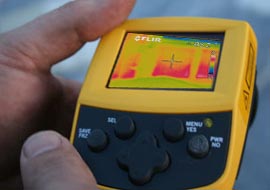
If scientists at the University of Florida have their way, water intrusion during a hurricane may someday be a thing of the past...

As restoration contractors and specialist in water intrusion issues, Complete, Inc., has seen the effects on the interior of buildings from wind-driven rain. The nature of the winds on a structure are such that they increase and decrease, causing the exterior components of the building to flex.
The common problems are wet sheetrock, insulation, trim, floor coverings, window blinds and sometimes wall sheathing. In many cases, a complicating factor is that many homeowners have evacuated and there is not the opportunity to remove or dry the water damaged building components before mold begins to grow.
The Environmental Protection Agency [EPA – www.epa.gov] identifies that mold growth can begin in as little as 24 to 48 hours. The need to understand how water moves through a structure that is subjected to hurricane-force winds and rain is key to designing and building wall assemblies that will function in the extreme Florida weather conditions.

The hurricane simulator is being used to emulate gusting and variable winds similar to those created by hurricanes. This process is being done through the use of very sensitive computer programs and science. Large rudders are used in the simulator to redirect and vary the airflow being produced; this is extremely important in creating an accurate reproduction of actual storm conditions.
If these resulting damages are not quickly resolved they often can lead to big time mold problems.

I recently got the opportunity to join a colleague of mine to view his newest project down in Gainesville FL. Forrest Master, PhD has designed and built with the help of many, a full size storm making machine. The scale of this project is immense and the stakeholders are virtually everyone.
From the people that write the building codes for homes, to the manufacturers that make the components, to the contractors that assemble them, the companies that write insurance for them, and most importantly to the families that live in them, everyone is affected by the need to keep water out of their homes.
The plan is to subject different wall assemblies to hurricane force winds and rain equaling 8.8 inches per hour with the use of four diesel engines and a rudder controlled wind making machine. When this beast starts up you better hold on because it is awesome it roars to life like the big bad wolf.
The test assemblies are hydraulically lifted into place and careful attention is being made to document any water that comes inboard of the interior window flanges and how that uncontrolled water intrusion got there. Forrest has a great crew of guys down there assisting him in the mechanics of the testing including graduate students, coastal engineering undergraduates and some staff.
The project received state funding and private donation last year but the recent cuts to the budget will slow the research. I believe this is one of the most important issues facing the citizens of the State of Florida today. With insurance costs spiraling out of control this would be a way to prove to the insurance companies that Florida is a market that they want to be in. If we can control the water getting into these homes we can lower the cost of claims and eventually that will result in lower premiums. We owe this to current future generations of Floridians.
Complete has enjoyed this learning process and looks forward to continuing our relationship and support of this fine project. If your organization needs a contractor or expert that is keeping current, Call Complete. We can determine the nature of water intrusion, establish the fix, and set the costs. Our background as experts in EIFS litigation has put us in a position to understand the real potential of this research. We thank Dr. Masters and all involved for allowing us to play a small part in this project.
